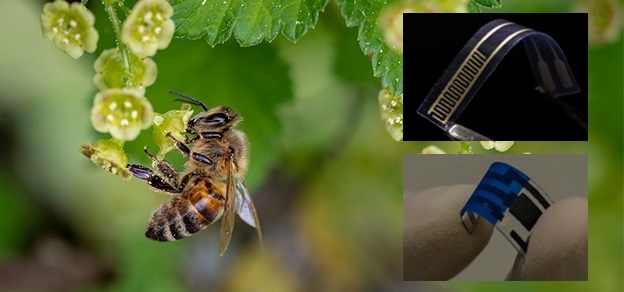


Developed by Brazilian researchers, the biosensor identifies the presence of different pathogens more quickly and cheaply than standard methods (photos: Talanta / Pixabay)
Published on 05/12/2021
By Elton Alisson in São Carlos (Brazil) | Agência FAPESP – A molecule derived from honeybee venom is the key component in an innovative biosensor designed to detect bacteria in food and drink faster and more inexpensively than standard methods.
The device was developed in Brazil by researchers affiliated with the University of São Paulo’s São Carlos Physics Institute (IFSC-USP), the Brazilian Agricultural Research Corporation (EMBRAPA) and the Federal University of São Carlos (UFSCar).
“The biosensor detects bacteria in very small food or drink samples. It’s highly sensitive and takes between ten and 25 minutes,” said Osvaldo Novais de Oliveira Junior, Full Professor at IFSC-USP and principal investigator for the project.
The conventional method entails analyzing the entire volume or mass, tracking the growth of the bacteria, and counting all the units in the colony. “This process can take 24 to 72 hours,” Oliveira Junior said.
The novel device resulted from postdoctoral research conducted by Deivy Wilson Masso at IFSC-USP with a scholarship from FAPESP and is described in an article published in the analytical chemistry journal Talanta.
The device consists of a film containing electrodes made of silver, which is a good conductor of electricity, and nanometric magnetic particles coated with melittin, which is an antimicrobial peptide extracted from bee venom.
When the device is placed in a water sample, for example, the melittin-coated magnetic nanoparticles attract and capture bacteria and are deposited on the silver electrodes, generating an electrical signal. The type of bacterium present in the water and the size of the colony can be detected by measuring the intensity of the signal.
In the case of solid foods, only a small sample needs to be ground, homogenized and filtered to perform the procedure, Oliveira Junior explained.
“The device can detect a very small amount of bacteria in the sample, corresponding to only one colony-forming unit per milliliter [CFU/ml],” he told during the Symposium on Research and Innovation in Functional Materials held at UFSCar on May 23-24, 2019, by the Center for Development of Functional Materials (CDMF), one of the Research, Innovation and Dissemination Centers (RIDCs) funded by FAPESP.
The biosensor is so sensitive that it is capable of detecting a colony of bacteria in minute samples of food or drink.
Use in hospitals
The researchers measured the biosensor’s performance in detecting bacteria of the species Escherichia coli, Staphylococcus aureus and Salmonella typhimurium in drinking water and apple juice.
The tests showed that the device was capable of detecting 1 CFU/ml of E. coli in drinking water and 3.5 CFU/ml in apple juice in only 25 minutes.
“The biosensor can be used for fast, low-cost screening to check the quality of food and drink products in supermarkets, restaurants and factories,” Oliveira Junior said.
The technology is being patented, and the materials used to make the device are inexpensive. “We won’t need to import any of its components. It will cost only about 30 cents of a Brazilian Real [now about USD 0.08],” he said.
The researchers plan to make a few adaptations to the device so that it can also be used to detect contamination in hospital wards, operating rooms, instruments and equipment.
The article “Electrical detection of pathogenic bacteria in food samples using information visualization methods with a sensor based on magnetic nanoparticles functionalized with antimicrobial peptides” (DOI: 10.1016/j.talanta.2018.10.089) by Deivy Wilson, Elsa M. Materón, Gisela Ibáñez-Redín, Ronaldo C. Faria, Daniel S. Correa and Osvaldo N. Oliveira Jr. can be retrieved from www.sciencedirect.com/science/article/pii/S0039914018311342?via%3Dihub.
Source: https://agencia.fapesp.br/31033